The wiki is lacking in content. You can help by creating a new article. See the to do list for more ways you can help.
Account creation has been restricted to people who have accounts. Please stop by the Discord Server to request an account.
Final Fantasy VI
| Final Fantasy VI | |
|---|---|
 Logo | |
|
ファイナルファンタジーVI | |
| Developer(s): | |
| Publisher(s): |
Square |
| Platform(s): |
Super Nintendo Entertainment System, PlayStation, Game Boy Advance, Virtual Console (Wii, Wii U, New Nintendo 3DS), iOS/Windows/Android phones, Super NES Classic Edition |
| Release date: |
Super Famicom/Super NES: |
| Genre: |
Role-playing game |
| Modes: |
Single player |
| Ratings: |
PlayStation: |
| This article is about the sixth installment of the Final Fantasy series, which is the third installment in North America, where it was named Final Fantasy III. For the third game in the series overall, see Final Fantasy III. |
Final Fantasy VI is the sixth main installment in the Final Fantasy series, developed and published by Squaresoft. It was released in April 1994 for the Super Nintendo Entertainment System in Japan, and released as Final Fantasy III in North America in October 1994. It was co-directed by Yoshinori Kitase and Hiroyuki Itou, taking over from Hironobu Sakaguchi, with Nobuo Uematsu composing the score and Yoshitaka Amano providing image design. Final Fantasy VI is the last game in the main series to feature two-dimensional graphics.
Like its predecessors, Final Fantasy VI has received several reissues, including on PlayStation, Game Boy Advance, iOS, Android, and Microsoft Windows. In North America, the PlayStation release was only included on the compilation, Final Fantasy Anthology. The Game Boy Advance remake is titled Final Fantasy VI Advance.
Final Fantasy VI focuses on a conflict between the Gestahlian Empire conquering the world and a rebel faction opposed to them known as the Returners. Contrary to the medieval settings of earlier Final Fantasy titles, Final Fantasy VI is set in a steampunk environment. The Empire is led by Emperor Gestahl and his clownish general Kefka Palazzo, who have rose to power by experimenting on captured Espers, magical beings of legend. The Returners seek magical power to fight the Empire on equal terms, and an amnesiac former imperial soldier, Terra Branford, proves key to both sides for understanding magic and espers.
Story[edit]
A thousand years before the events of the game, three entities known as the Warring Triad initiated a conflict that would be known as the War of the Magi. This quarrel grew to catastrophic proportions, unleashing magical energy into the world which transformed afflicted humans into Espers, who would become soldiers in the war. Eventually realizing the horrific calamity wrought by their hands, the Triad returned free will to the Espers and sealed their own powers, becoming stone statues. Their only request was that the Espers ensure their power remain locked away so it might never be used again. The Espers carried their stone gods to a hidden land, sealing both the statues and themselves off from the realm of humans. The concept of magic gradually faded to legend and myth as mankind built a society extolling science and technology.
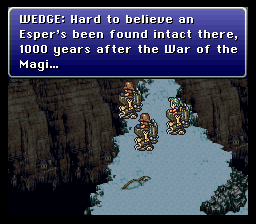
Final Fantasy VI starts with Terra, who is under mind control, participating in an imperial raid on Narshe with Biggs and Wedge in search of a recently unearthed frozen Esper (later revealed to be Valigarmanda) found in Narshe Mines. The esper kills Biggs and Wedge and destroys the Slave Crown controlling Terra, who cannot remember anything besides her name and her rare ability to use magic unaided. Locke Cole, a treasure hunter, promises to protect her until she can regain her memory and helps her escape to the Returners Hideout. Along the way, they pass through Figaro and meet its king, Edgar, and his estranged brother, Sabin, who join their party.
Banon, the leader of the Returners, asks for Terra's help in their struggle against the Empire, and she agrees. Just as the Returners prepare to return to Narshe to investigate the frozen esper, the Empire attacks South Figaro. Locke heads to the besieged town to slow the Empire's advance, while the rest of the group makes their way via rafting down the nearby Lethe River. However, Sabin is separated from the group after a battle with a purple octopus named Ultros, forcing the various members of the Returners to find their own ways to Narshe in three different scenarios. The player can decide on the order in which they do the scenarios. In Locke's scenario, he must escape South Figaro without being detected. In Sabin's scenario, he has been swept to a distant continent and must find a way back. In the third and final scenario, Terra, Edgar, and Banon continue riding down the Lethe River back to Narshe.
The characters eventually reunite in Narshe. Locke brings Celes Chere, one of the Empire's own generals, whom he saved from execution for defying the Empire's ruthless practices. Sabin brings with him Cyan Garamonde, whose family was killed during the Empire's siege of Doma Castle when Kefka ordered the water supply poisoned, and Gau, a feral child he befriended on the Veldt. In Narshe, the Returners prepare to defend the frozen Esper from the Empire. Once they thwart the Imperial invasion, Terra approaches the frozen Esper, prompting her to transform into an Esper-like form herself. She flies away feeling confused and horrified by her own transformation.
The Returners set out to search for Terra and eventually trace her to the city of Zozo. They meet another esper, Ramuh, who tells them that if they free various other espers from the Magitek Research Facility in the Empire's capital, Vector, they may find one who can help Terra. Vector is on the southern continent, to which the Empire does not allow maritime access, so the Returners go to the Opera House and recruit Setzer Gabbiani, who is believed to be the owner of the world's only airship, the Blackjack. They then travel to Vector and attempt to rescue several Espers, including Maduin, who is revealed to be Terra's father. However, the espers are already dying from the experiments at Vector, and choose instead to give their lives to transform into Magicite, the crystallized remains of the espers' essences that form when they die and allow others to use their powers. Before the group can escape, Kefka arrives and causes the Returners, including Locke, to momentarily doubt Celes' loyalty, much to her anguish. Celes provides proof of her support by covering for the group while they escape. The party then returns to Zozo, where Terra reacts to the Magicite of her father, prompting her to regain knowledge of her past and accept herself as the half-human, half-esper child of Maduin and a human woman.
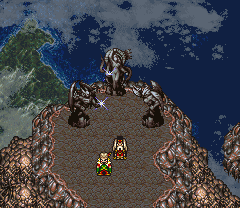
After reuniting with Terra, the Returners decide to launch an all-out attack on the Empire, and Banon asks Terra to attempt contacting the Espers' land in order to gain their support. When the Espers learn that the captured Espers have perished, they become infuriated and enter the human world, where they destroy much of Vector. When the Returners arrive in the capital, they find Emperor Gestahl claiming to no longer have the will to fight, inviting the Returners to a banquet to negotiate peace. Gestahl asks Terra to deliver a truce to the Espers on his behalf, to which she agrees. Accompanied by Locke, Shadow (a ninja mercenary hired by the Empire for the mission), Generals Celes and Leo, the player must then guide Terra to the remote village Thamasa in search of the Espers, where they meet Strago Magus and his granddaughter, Relm Arrowny, who also accompany them.
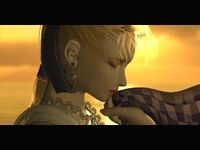
Soon, they find the Espers and Terra convinces them to accept a truce with Gestahl. During the negotiations, Kefka attacks the Espers, killing each of those still alive and capturing the Magicite that remains from their essence. Additionally, he kills General Leo, who is appalled by Kefka's dishonorable tactics and attempts to defend the Espers. The Returners reunite, now aware that the peace was a ploy for Gestahl to obtain Magicite and the stone statue remains of the Warring Triad within the Espers' now-unsealed land. Kefka and Gestahl travel through the open gate to the Esper world, find the Warring Triad, and prompt the island on which the Esper world is located to detach and fly in the sky as an ominous Floating Continent. The Returners, despite their efforts, are unable to prevent Kefka and Gestahl from gaining the power of the statues. Now empowered, Kefka promptly kills Gestahl and moves the statues out of their proper alignment, upsetting the balance of magical power and causing the destruction of most of the surface world. In the disaster, the Returners are separated from one another as Setzer's airship is torn apart.
One year later, Celes awakens from a coma on a deserted island, Solitary Island, and learns that Kefka has taken over the world, which has gone from the World of Balance to the World of Ruin. Much of the human population has died, and plant and animal life are slowly being killed by sickness. Celes sets out to try and reunite with as many of her friends as she can find. Celes is only required by the game's story to reunite with Edgar and Setzer, who leads them to the Falcon, an airship that belonged to a deceased friend. In a series of mostly optional side-quests, the player is given the opportunity to gather the entire group and two new allies, Umaro and Gogo. Together, the Returners launch a new offensive against Kefka's Tower. Inside, the Returners battle their way through Kefka's defenses and destroy the three statues, the source of Kefka's newfound power. When destroying the statues does not cause any noticeable reaction, the party realizes that Kefka has drained the Warring Triad of their magical power for himself.
Making a final stand against Kefka, the characters destroy him, but since the gods' power had come to reside in him all magicite begins to shatter and Kefka's magically-maintained tower begins to crumble. The Returners make their escape, although if Terra is present, she begins to weaken due to her half-Esper heritage. Before Maduin's Magicite shatters, he informs Terra that by holding to the human side of herself, she may survive the passing of magic. In the end, the party escapes Kefka's Tower aboard the Falcon. Terra survives, and the group observes the world as it rejuvenates.
Gameplay[edit]
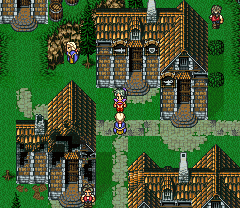
Like the previous Final Fantasy installments, Final Fantasy VI consists of four basic modes of gameplay: a world map, town and dungeon field maps, a battle screen, and a menu screen. The world map allows the party to travel to various locations. As with most games in the series, the three primary means of travel across the overworld are by foot, chocobo, and airship. Enemies are randomly encountered on the world map if the party travels by foot. The menu screen is where the player decides which equipment the party will use, the magic they learn, and to track their experience points and levels. The game allows for up to fourteen playable characters, the largest cast in the series. A party can have up to four characters at once, although some events require the player to assemble three different parties and switch between them.
In towns, the party can talk to citizens to learn useful information and be given hints that help them on their journey. Many towns have shops, such as an Item Shop, which sells various items, a Weapon Shop, which sells weapons, and an Armor Shop, which sells armor. Most towns have an inn, where the party can rest to have their HP and MP fully restored.
Dungeons take place in a variety of settings, including caves, forests, and buildings. Many dungeons have uncommon items that are not sold in Item Shops. Most items are obtained from treasure chests, which are found in both subterranean and town areas. Sometimes an item can be found in an urn. Some homes have an Elixir (an item that fully restores the HP and MP of one character) inside of a grandfather clock.
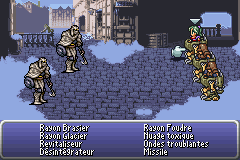
During battle, the player must decide on commands for each character, such as Fight, Magic, and Items. From the Config menu, the player can decide on whether the battles are Active Time Battles or turn-based. They can also select the Defend command in a submenu to have a character skip a turn during battle. Each character has an action bar that replenishes itself at a rate dependent on their speed statistic. When a character's action bar is filled, the player may assign a command to that character. If more than one action bar is filled, the order in which character's command is selected depends on whose action bar filled up the soonest.
Each character has a unique command ability. Unlike other RPG games, where the player selects from a set of moves, a few characters in Final Fantasy VI have a unique way of activating their attack. Sabin's Blitz attack has players input different button commands like a fighting game to execute one of several moves. Cyan's Bushido has a bar that loads slowly from 1 to 8, and can be stopped by pressing a button. Each number represents a different attack, with the one at '8' being the strongest.
Final Fantasy VI is unique for its Desperation Attack, a powerful attack substitution that occasionally appears when a character's health is low. Characters are rewarded for victorious battles with experience points and gil. When characters attain a certain amount of experience points, they gain a level, which increases their statistics. The game also introduces Relics, which have a variety of uses and effects, and are almost entirely interchangeable among party members. Many Relics are sold in Relic Shops, which are found in certain towns.
At first, only two playable characters start with the ability to use magic, which can later be taught most other playable characters through Magicite and the powerful being contained within, known as an Esper. Magicite can be equipped to individual party members, who can only summon the contained Esper once per battle. Each Magicite has a specific set of magic spells that a character can learn from earning AP during battle. Some Magicite also grant a statistical bonus to a character when they gain a level.
Development[edit]
| This section uses content from Wikipedia (view authors), and falls under the compatible Creative Commons license. |
Final Fantasy VI began development in December 1992, after the release of its predecessor, Final Fantasy V.[1] The development of the game took just one year to complete.[2] Hironobu Sakaguchi could not be as intimately involved as in previous installments due to his other projects and his promotion to Executive Vice President of the company in 1991.[1] For that reason, he became the producer and split director responsibilities for Final Fantasy VI up between Yoshinori Kitase and Hiroyuki Ito: Kitase was in charge of event production and the scenario, while Ito handled all battle aspects. Sakaguchi supervised Kitase's cutscene direction and ensured that the project would coalesce as a whole. The idea behind the story of Final Fantasy VI was that every character is the protagonist. All members of the development team contributed ideas for characters and their "episodes" for the overall plot in what Kitase described as a "hybrid process". Consequently, Terra and Locke were conceived by Sakaguchi; Celes and Gau by Kitase; Shadow and Setzer by graphic director Tetsuya Nomura; and Edgar and Sabin by field graphic designer Kaori Tanaka.[1] Then it was Kitase's task to unite the story premise provided by Sakaguchi with all the individual ideas for character episodes to create a cohesive narrative.[1][3] The scenario of Final Fantasy VI was written by a group of four or five people, among them Kitase who provided key elements of the story, such as the opera scene and Celes' suicide attempt, as well as all of Kefka's appearances.[4]
Yoshitaka Amano's concept art became the basis for the models in the full motion videos produced for the game's PlayStation re-release. Tetsuya Takahashi, one of the graphic directors, drew the imperial Magitek Armor seen in the opening scene. By doing so, he disregarded Sakaguchi's intention to reuse the regular designs from elsewhere in the game. The sprite art for the characters' in-game appearance was drawn by Kazuko Shibuya. While in the earlier installments, the sprites were less detailed on the map than in battle, Final Fantasy VI's had an equally high resolution regardless of the screen. This enabled the use of animations depicting a variety of movements and facial expressions. Final Fantasy VI makes more extensive use of Mode 7 than its predecessors, such as the world map, which lends a somewhat three-dimensional perspective to an otherwise two-dimensional game.
Release history[edit]
Localization and censorship[edit]
- Main article: Final Fantasy VI version differences
- Main article: Final Fantasy VI regional differences
| This section uses content from Wikipedia (view authors), and falls under the compatible Creative Commons license. |
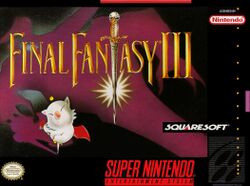
The original North American localization and release of Final Fantasy VI for the Super Nintendo Entertainment System featured several changes from the original Japanese version. The most evident is the change of the game's title from Final Fantasy VI to Final Fantasy III; because only two games of the main series had been localized in North America at the time, Final Fantasy VI was distributed as Final Fantasy III to maintain naming continuity. This is like how the North American Super Nintendo release of Final Fantasy IV was titled Final Fantasy II. The original North American localization has no major differences in gameplay, though several changes of contents and editorial adjustments exist in the English script to comply with Nintendo's censorship policies at the time. This resulted in some nude graphics being censored, building signs in towns were renamed (e.g. Bar was renamed to Café), and religious allusions (e.g. the Holy spell being renamed to Pearl). Some direct allusions from the Japanese version were also changed. References to death were also removed, such as when Kefka ordered the Magitek Soldiers to kill the party members; in the North American version, Kefka simply ordered his soldiers to chase after the group.
Besides censorship, the localization also featured changes to several names, such as "Tina" being changed to "Terra". Dialogue text files had to be shortened due to the limited data storage space available on the game cartridge's read-only memory. The translation for the game was done in 30 days by Ted Woolsey alone.[5]
Subsequent English re-releases, starting with the PlayStation version, retained the Final Fantasy VI title. These versions also received minimal changes from the original Japanese release. A few item and character names were adjusted, such as "Fenix Down" to Phoenix Down.
The Game Boy Advance re-release, Final Fantasy VI Advance, has a different translation that was done by Tom Slattery. While most of the character names, location names, and terminology were retained, item and spell names were updated to match the conventions used in more recent Final Fantasy games at the time.
Re-releases[edit]
Final Fantasy VI was ported to the PlayStation by Tose and re-released in Japan and North America in 1999. In Japan, it was available in both a standalone release and as part of Final Fantasy Collection, while in North America it was only available on Final Fantasy Anthology. In Europe it was sold only as a standalone release, and was the first time where the game released in Europe. 50,000 limited-edition copies were also released in Japan and included a Final Fantasy-themed alarm clock.[citation needed]
Final Fantasy VI's PlayStation port is very similar to the original Japanese Super Famicom release. With the exception of the addition of two full motion video opening and ending sequences and new screen-transition effects used for the start and end of battles, the graphics, music and sound are left unchanged from the original version. The only notable changes to gameplay (in addition to loading times not present in the cartridge versions) involve the correction of a few software bugs from the original and the addition of a new "memo save" feature, allowing players to quickly save their progress to the PlayStation's RAM. The re-release included other special features, such as a bestiary and an artwork gallery. On December 18, 2012, the port was re-released as part of the Final Fantasy 25th Anniversary Ultimate Box package in Japan.
In 2006, Tose ported the game to Game Boy Advance, on which it was released as Final Fantasy VI Advance. It was released in Japan by Square Enix on November 30, 2006, with Nintendo handling publishing in North America on February 5, 2007, and in Europe on July 6. It was the last Game Boy Advance game that released in Asia and the last game that Nintendo published for the system.
The original Super Famicom version was released for the Wii Virtual Console in Japan on March 15, 2011, in Europe and Australia on March 18, 2011, and in North America on June 30, 2011. The game was released in the West with its original North American title of Final Fantasy III. The Super Famicom version was later released on the Wii U Virtual Console in Japan. In September 2017, Nintendo re-released Final Fantasy VI as one of the games included on the Super NES Classic Edition and its Japanese counterpart, the Super Famicom Classic Edition.
Final Fantasy VI was re-released as a PSone Classic in Japan on April 20, 2011, in Europe and Australia on June 2, 2011, and lastly North America on December 6, 2011.
Ports of Final Fantasy VI for Android and iOS systems were announced in 2013 and released on January 15, 2014 and February 6, 2014 for Android and iOS respectively. This version features mobile-adapted controls and save features, but redrawn, slightly blurry graphics. A Microsoft Windows version, itself a port of the Android version, was released for Windows PC via Steam on December 16, 2015. The Steam release has controls optimized for PC, Steam achievements and trading cards.
References[edit]
- ^ a b c d "The Making Of... Final Fantasy VI". Edge volume 251, pages 124–127.
- ^ "Final Fantasy VI Took Just One Year To Make Says Director Yoshinori Kitase". Siliconera. Published August 6, 2013.
- ^ "Interview with Hironobu Sakaguchi". Shūkan Famitsū (Wayback Machine)
- ^ "Final Fantasy: Kitase's Inside Story". 1up.com (Wayback Machine)
- ^ "Final Fantasy VI Advance Review". Eurogamer (Wayback Machine).
 This article is a stub. You can help the Final Fantasy Wiki by expanding it.
This article is a stub. You can help the Final Fantasy Wiki by expanding it.